Abstract
1. The force of contraction and the membrane potentials have been measured from preparations of frog heart, with methods that also allow the rapid exchange of the extracellular fluid.
2. In regularly beating preparations, caffeine induces only weak contractures at temperatures above 15° C, but it does cause a marked potentiation of the twitch responses; longer exposure results in a depression of contraction. The build up and decline of the twitch strength, on addition and on removal of caffeine approximates to a single exponential, time constant 26-45 sec, and this time constant is not altered by variation of the [Ca]o, the stimulus rate or the caffeine concentration. This time course of the change of twitch strength is less complex than the changes seen when either [Ca]o or the stimulus rate is altered, suggesting a more direct action of caffeine on excitation-contraction coupling.
3. Caffeine increases the strength of the contractures initiated by potassium-rich or sodium-depleted solutions in isolated atrial trabeculae.
4. After the spontaneous relaxation of the contracture, evoked by either sodium-free or potassium-rich fluids, the application of caffeine initiates a redevelopment of tension. This caffeine contracture is transient and its strength is dependent on the caffeine concentration. The response in sodium-free solution can be elicited in the virtual absence of extracellular calcium.
5. Local anaesthetics antagonize the caffeine contracture.
6. The results suggest that the sarcoplasmic reticulum of frog heart muscle plays an important role in the initiation and control of contraction and relaxation.
Full text
PDF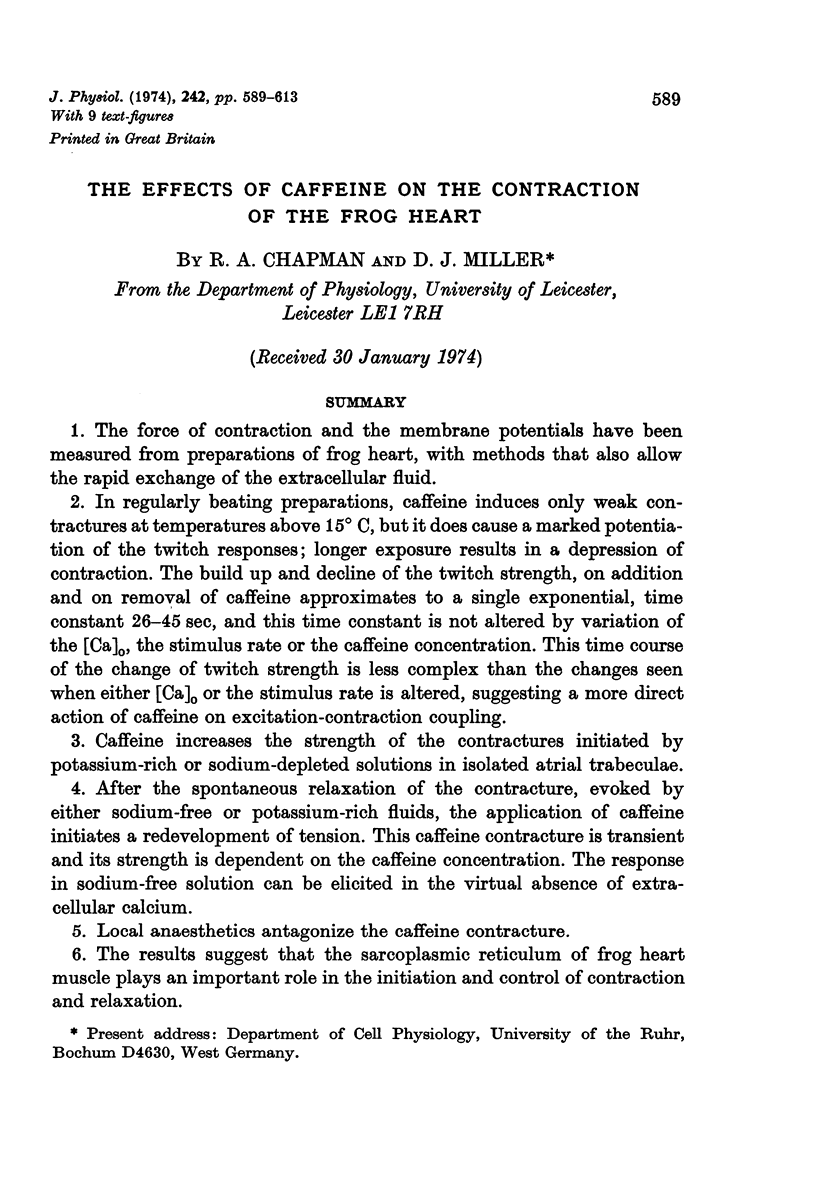
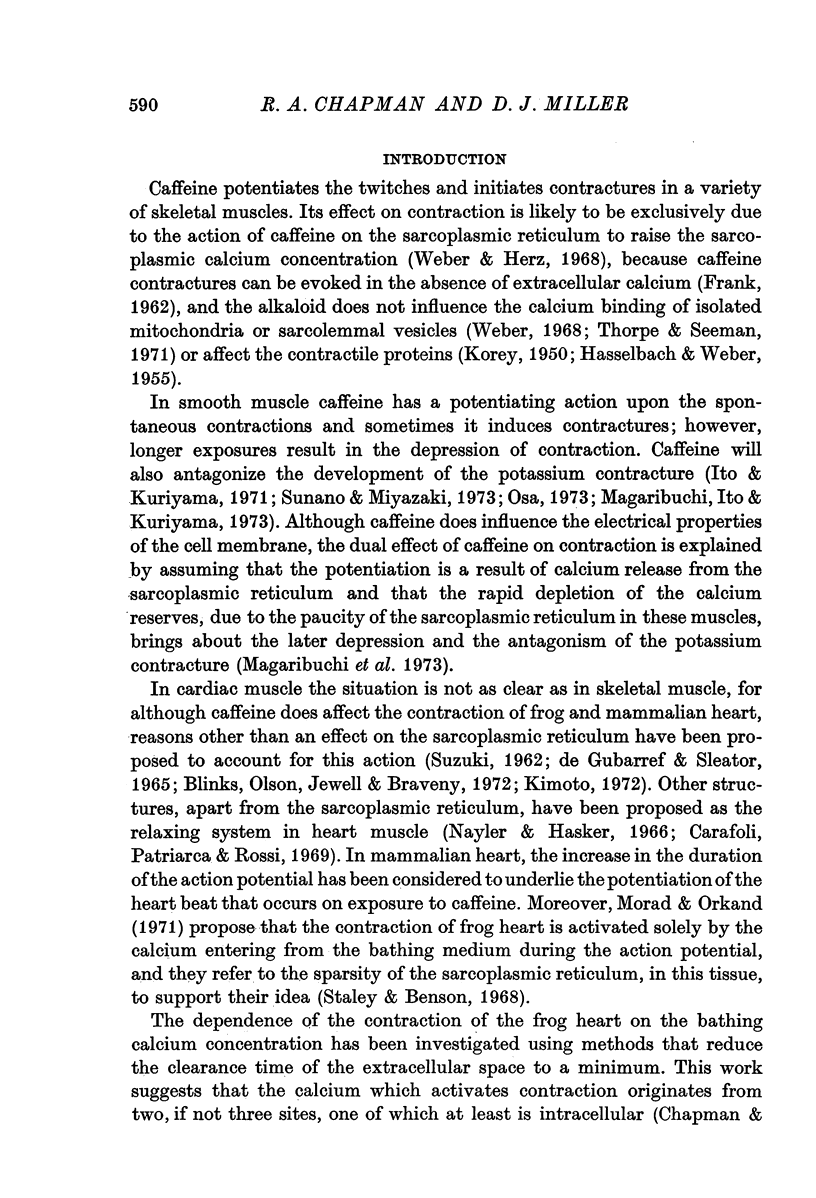
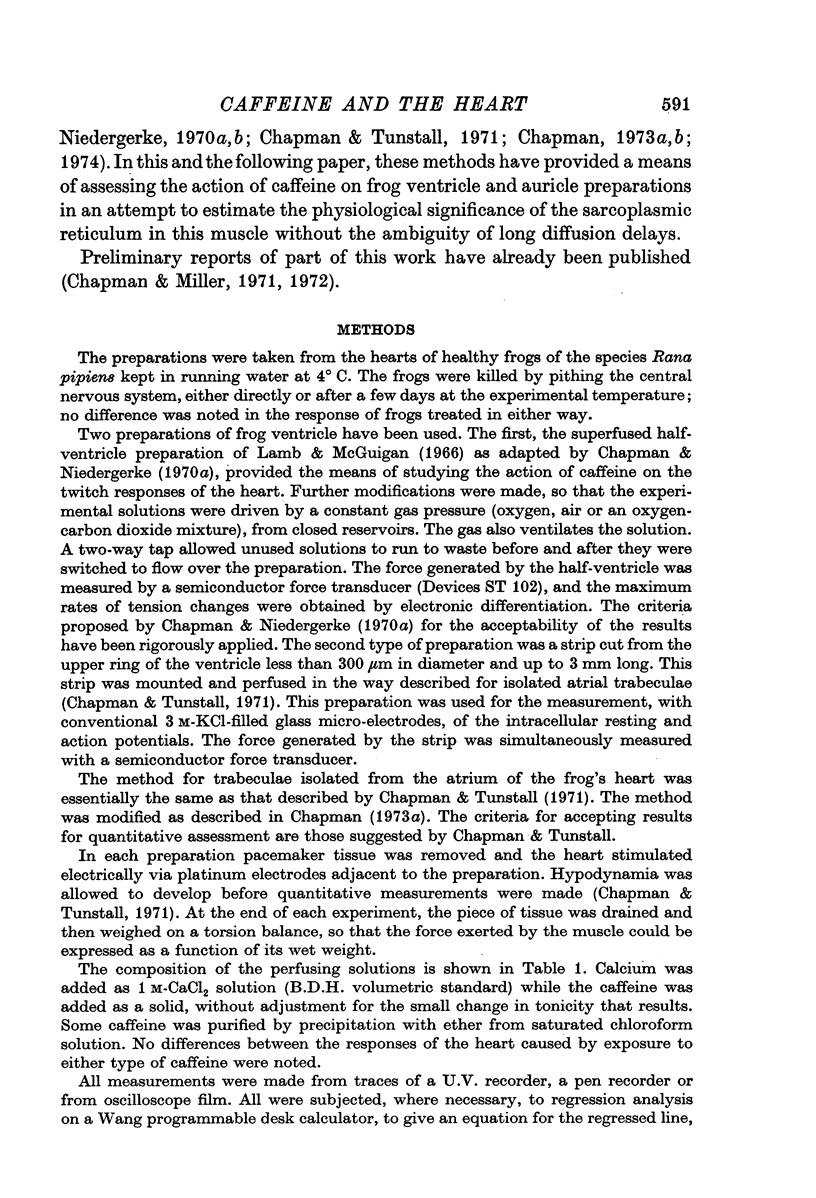
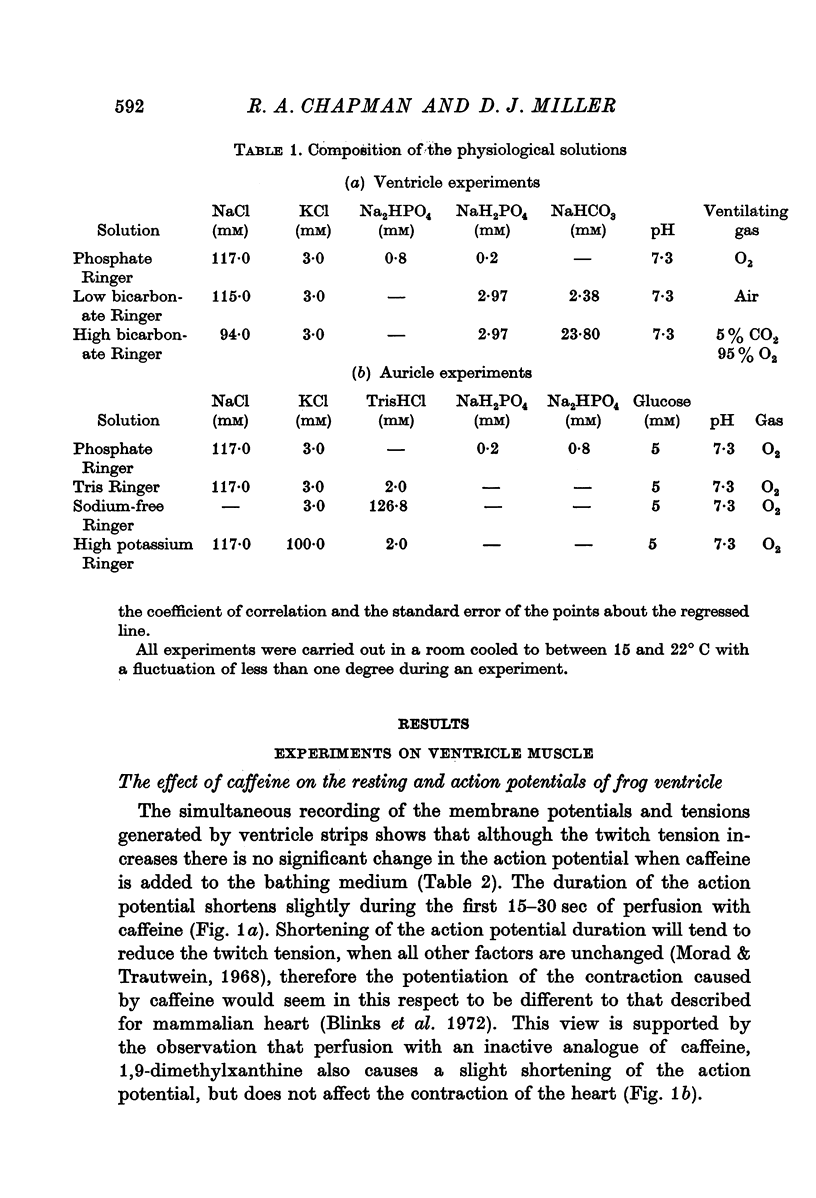
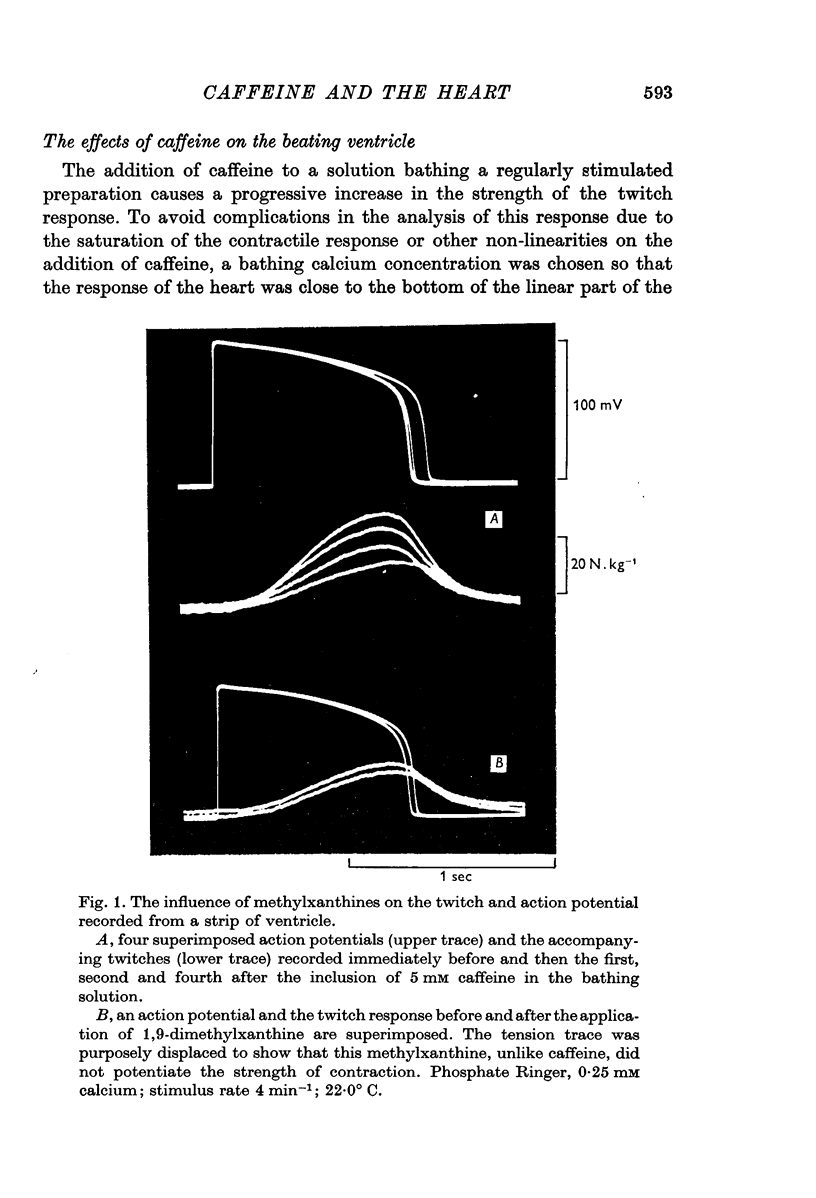
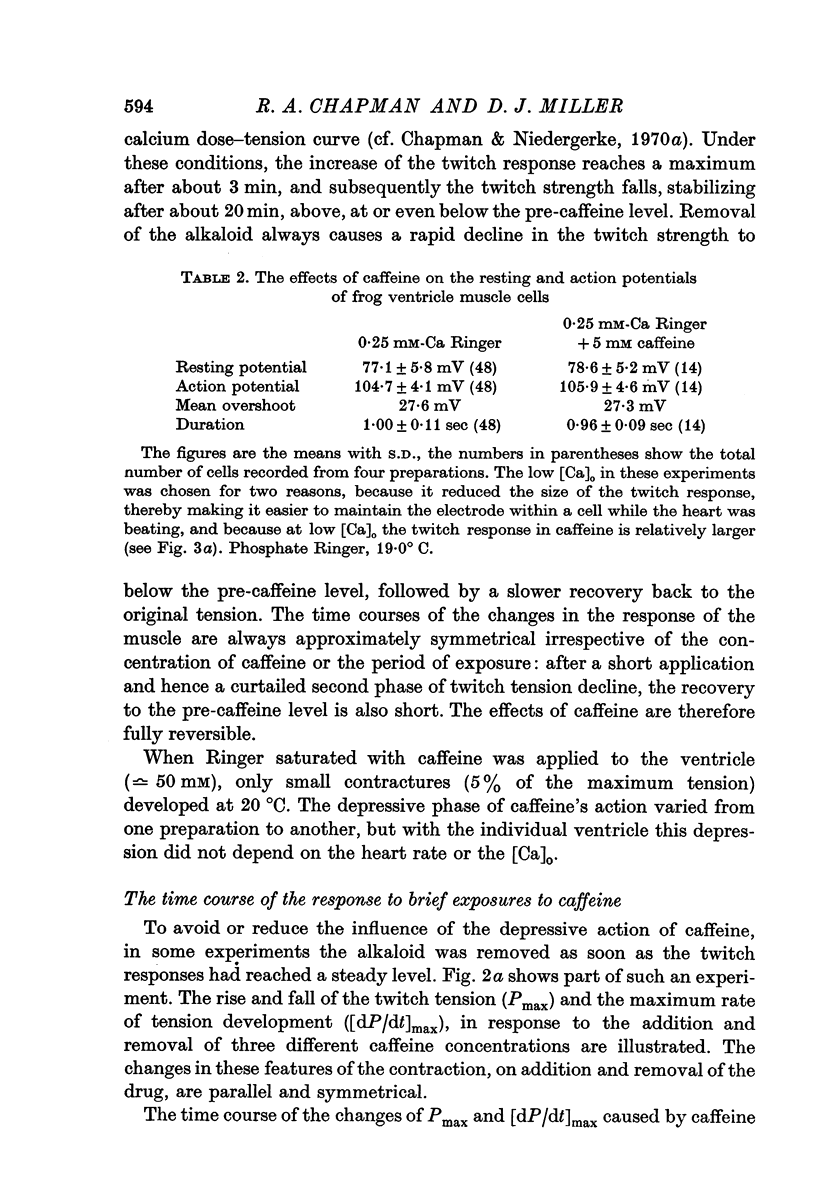
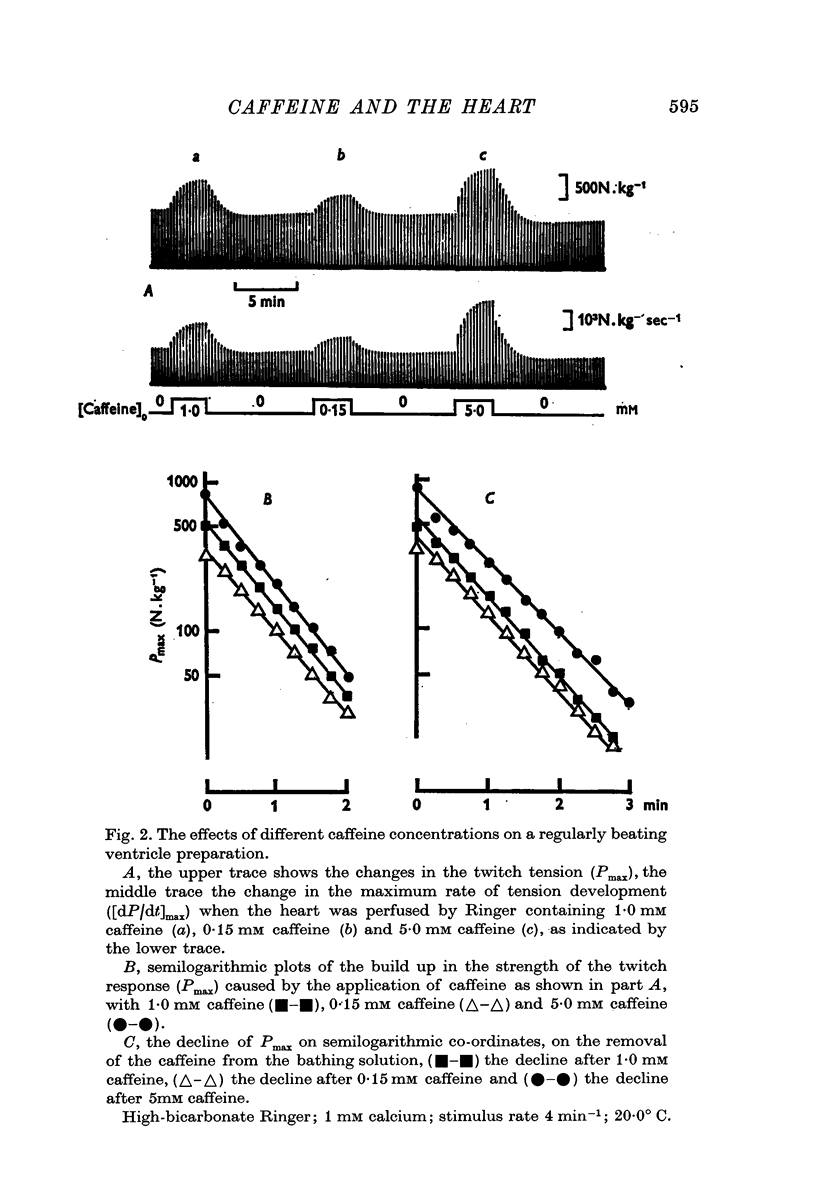
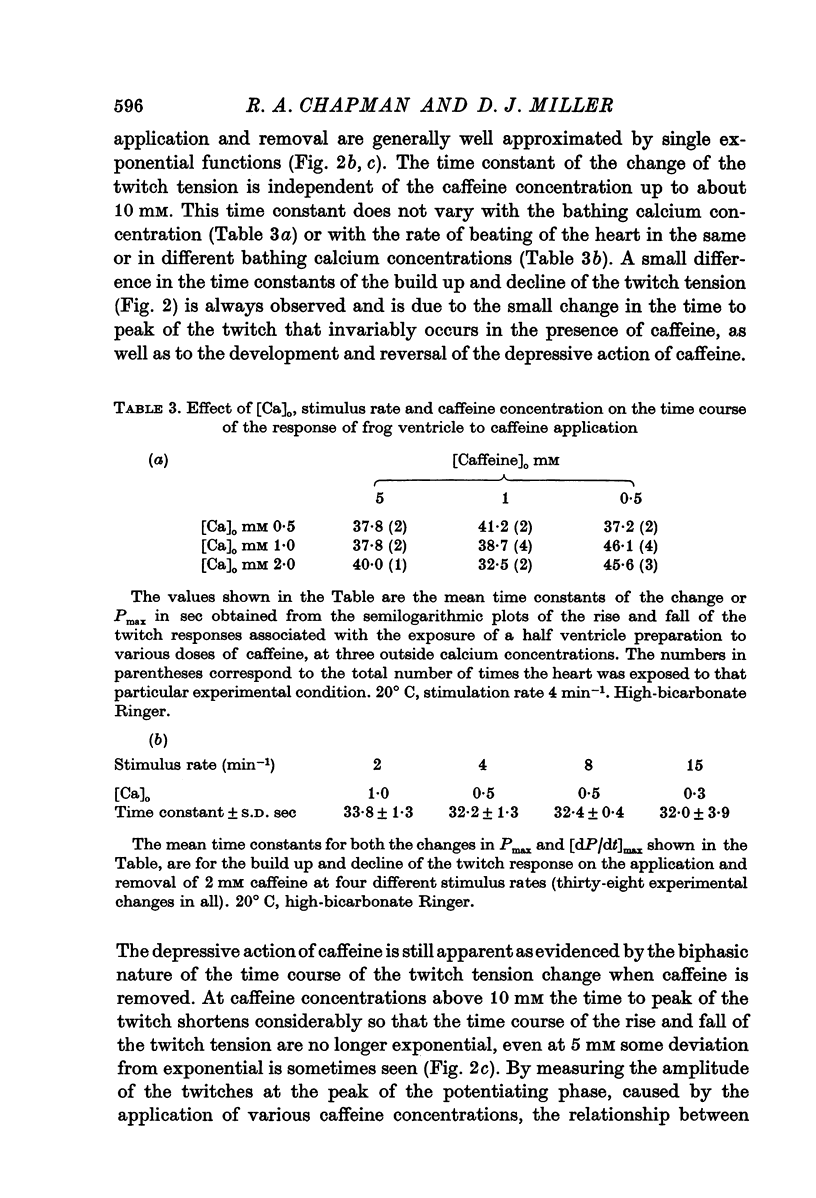
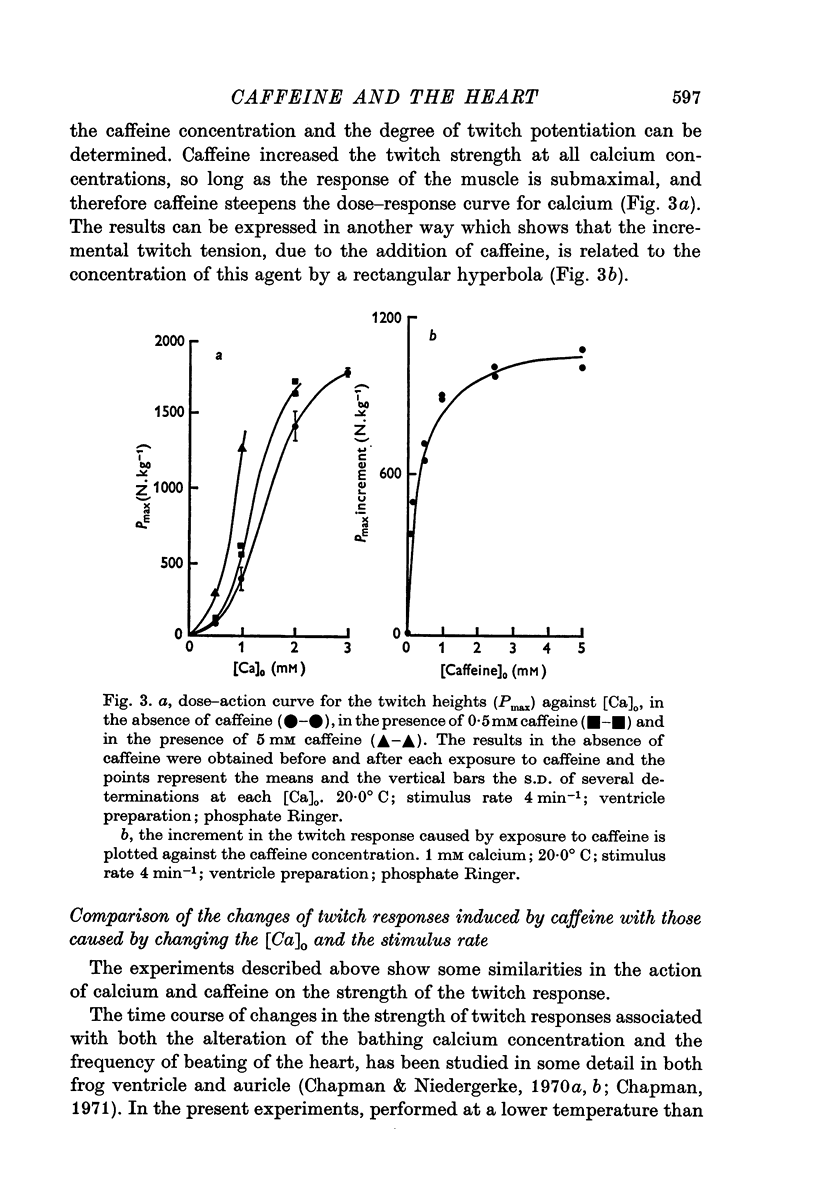
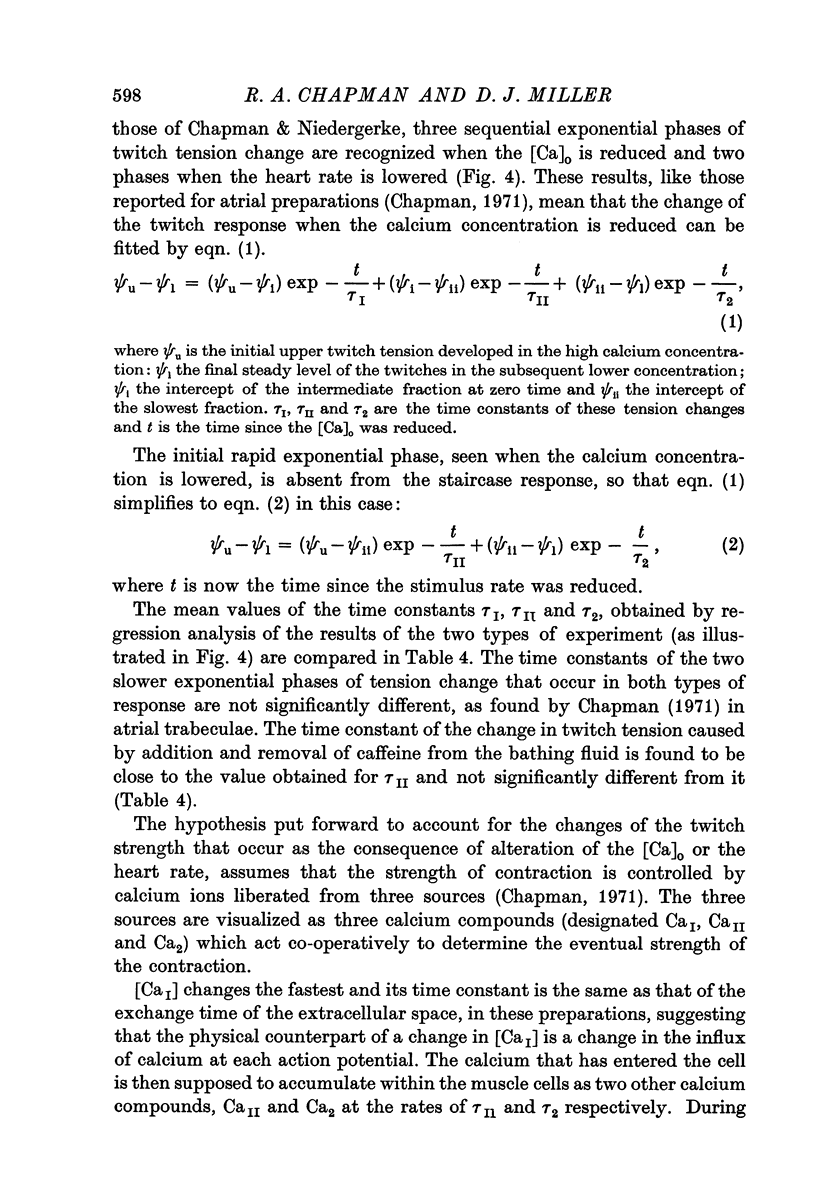
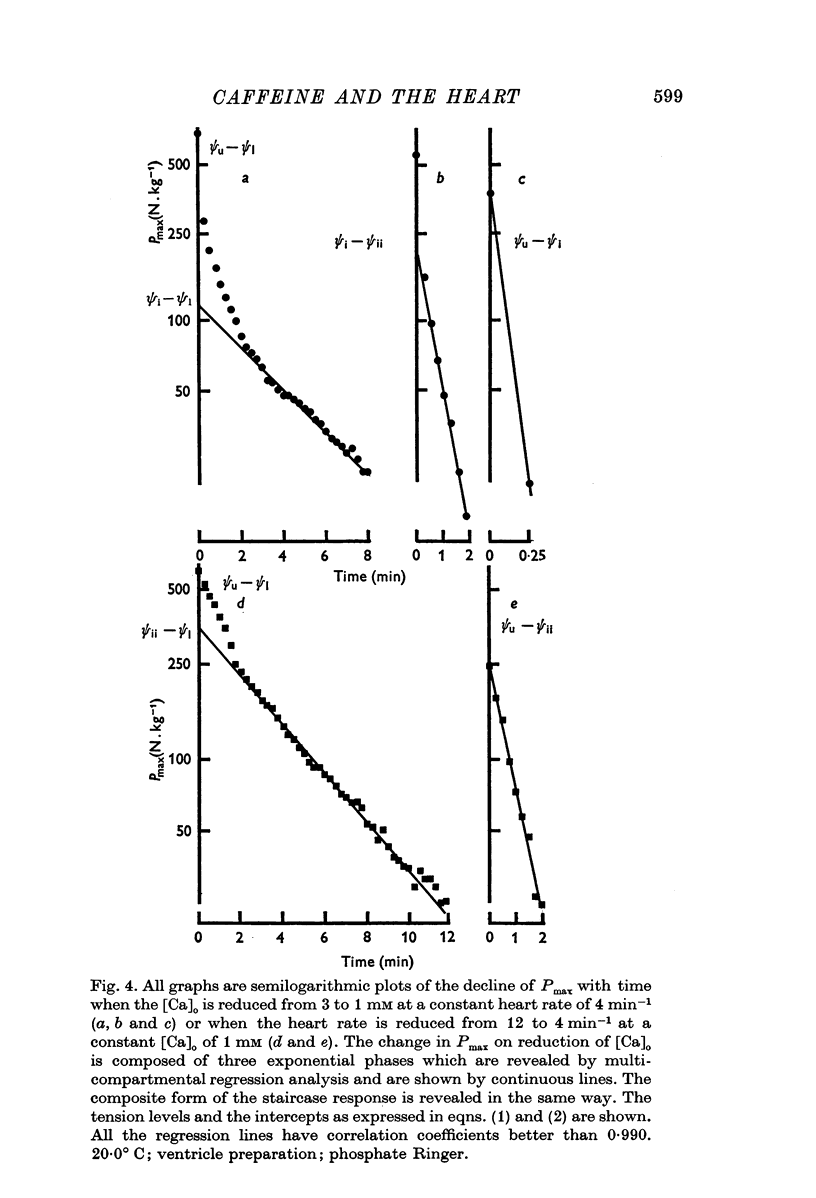
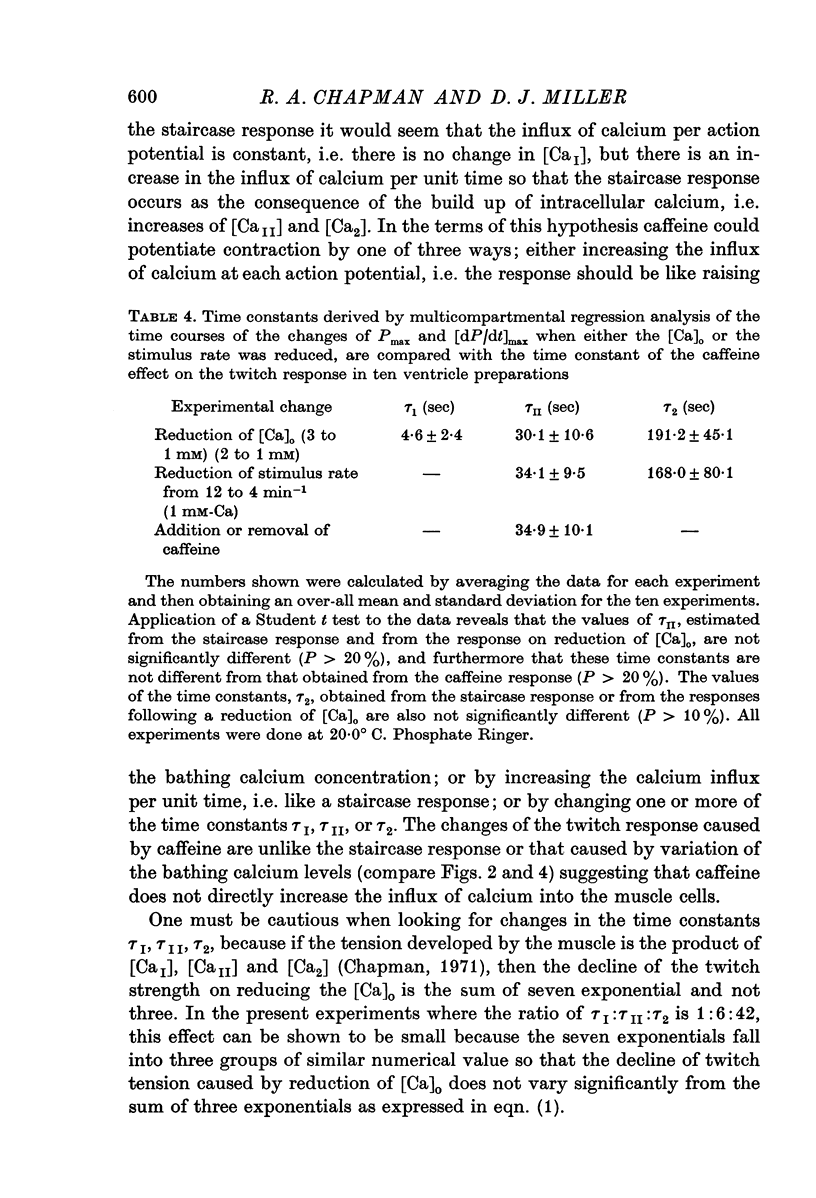
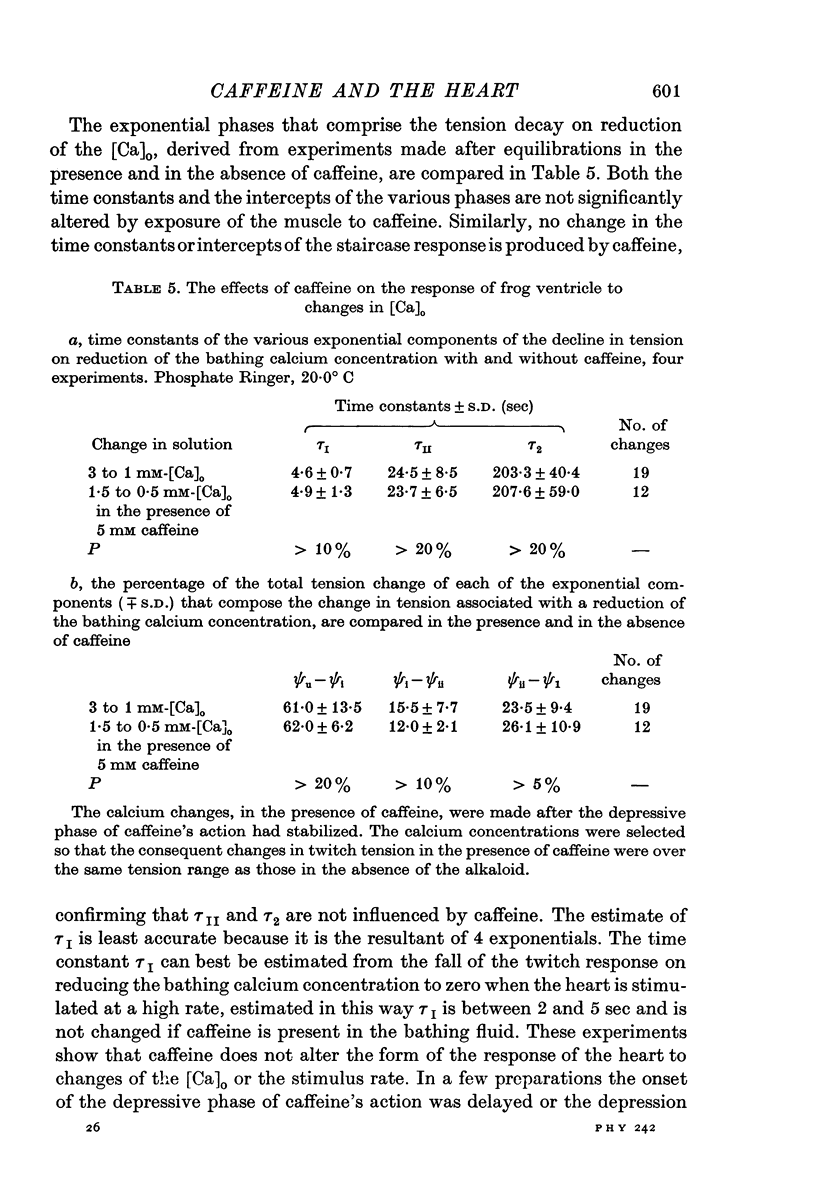
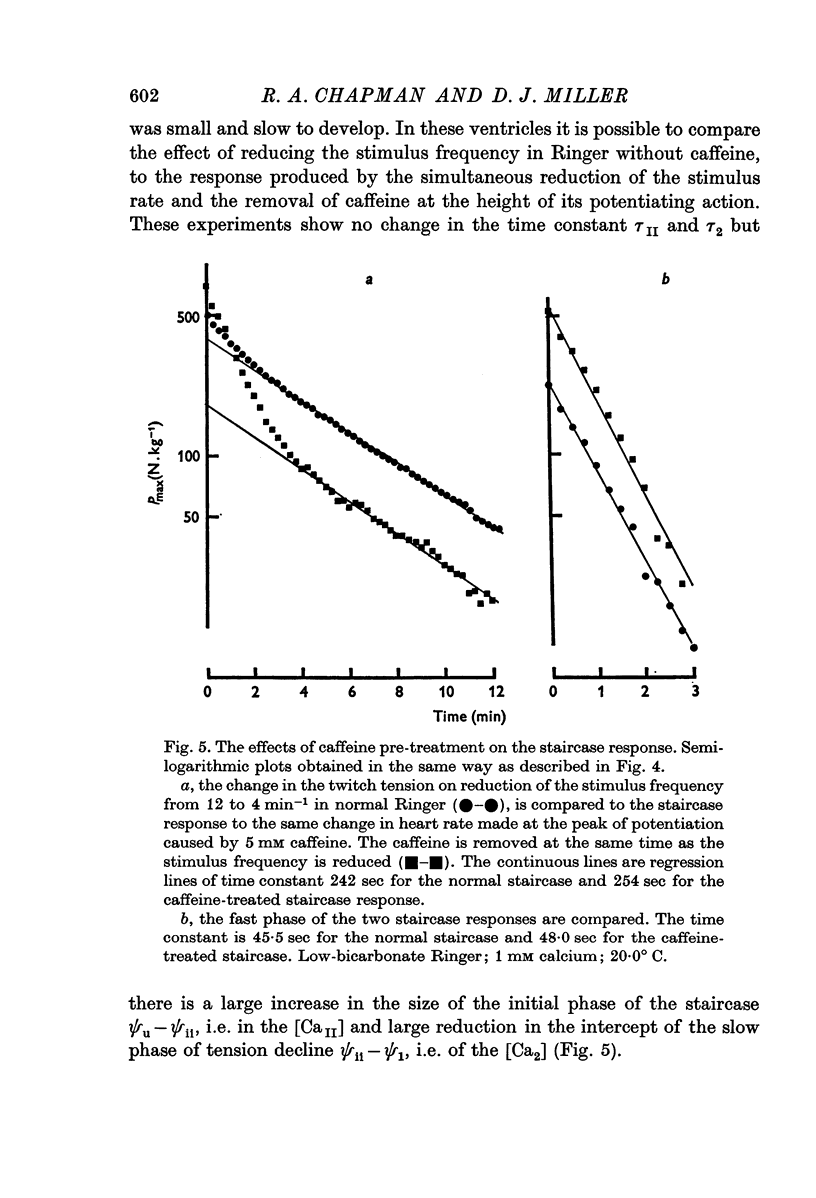
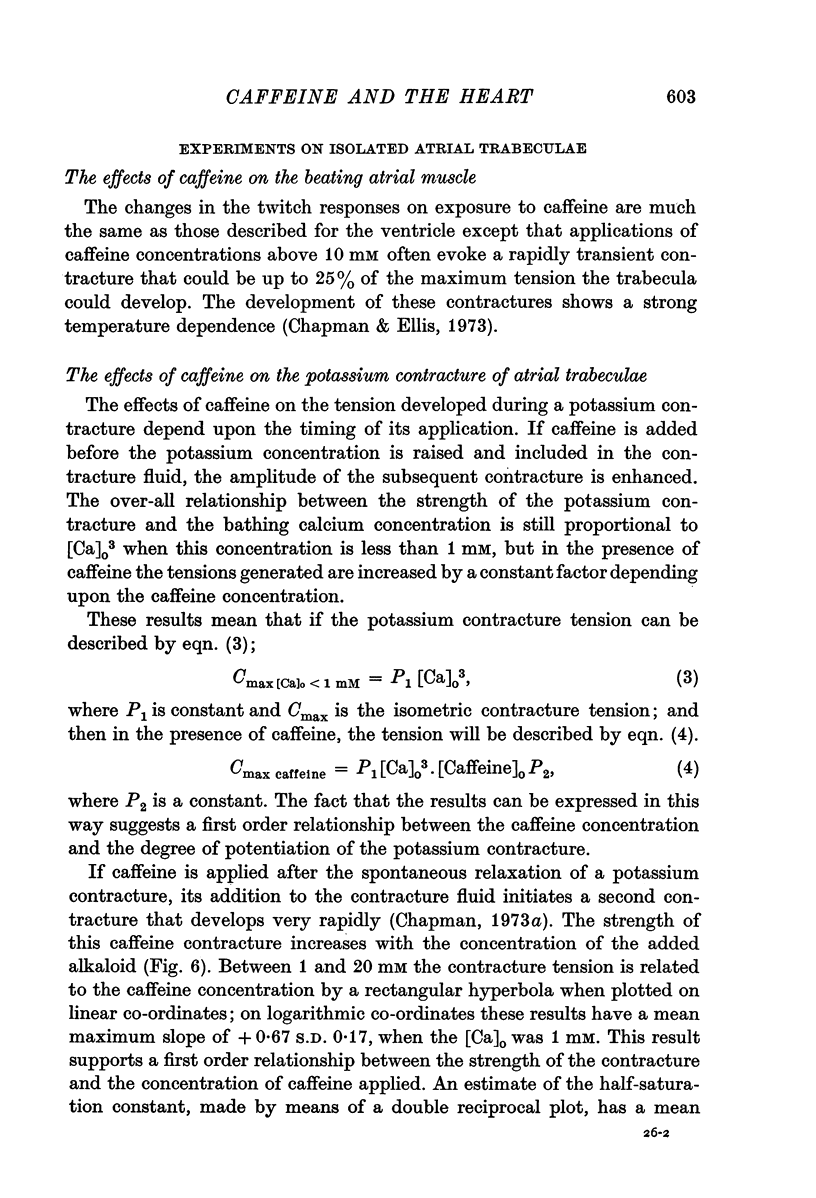
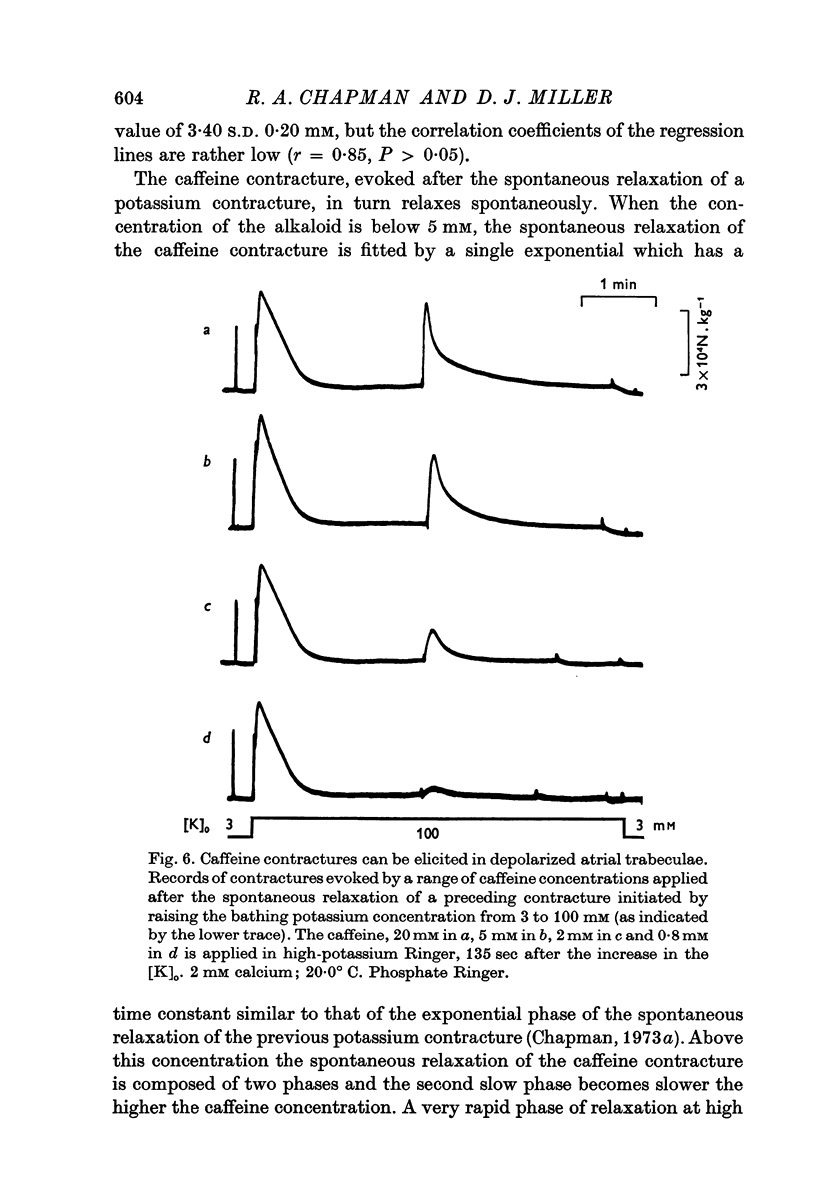
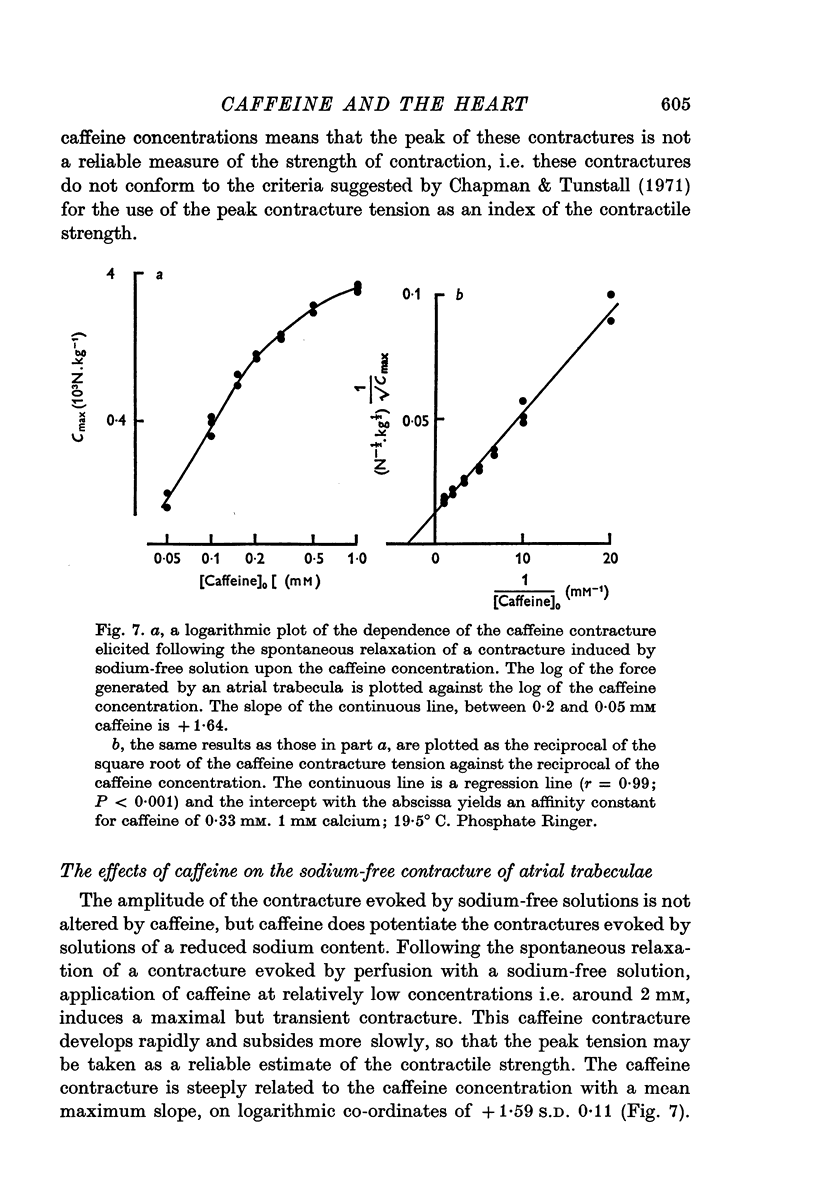
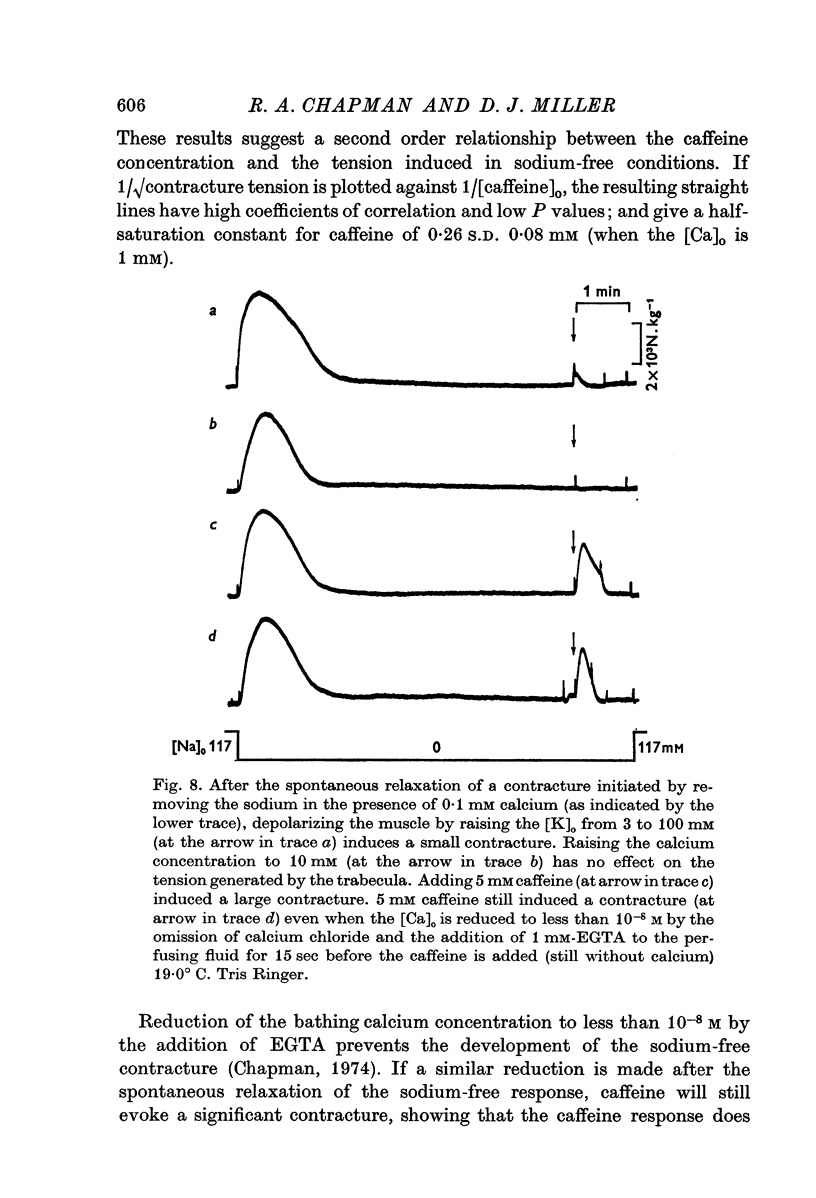
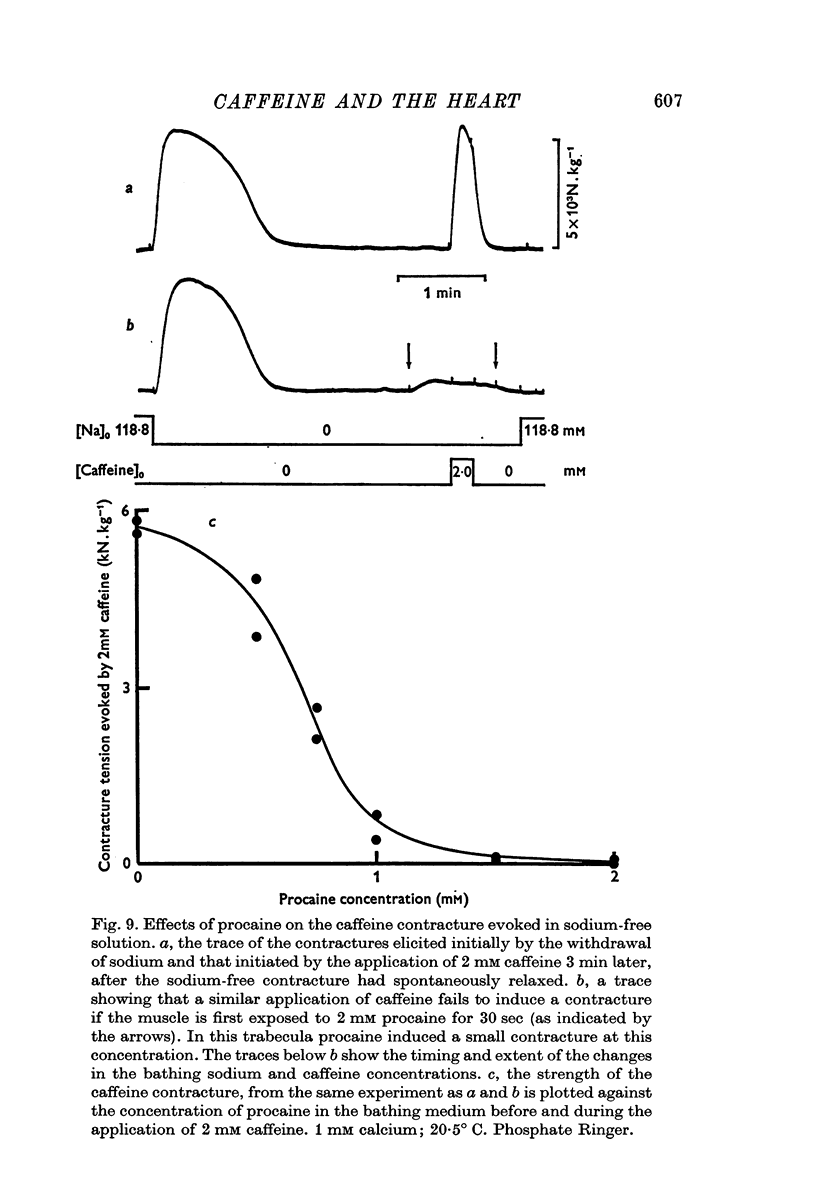
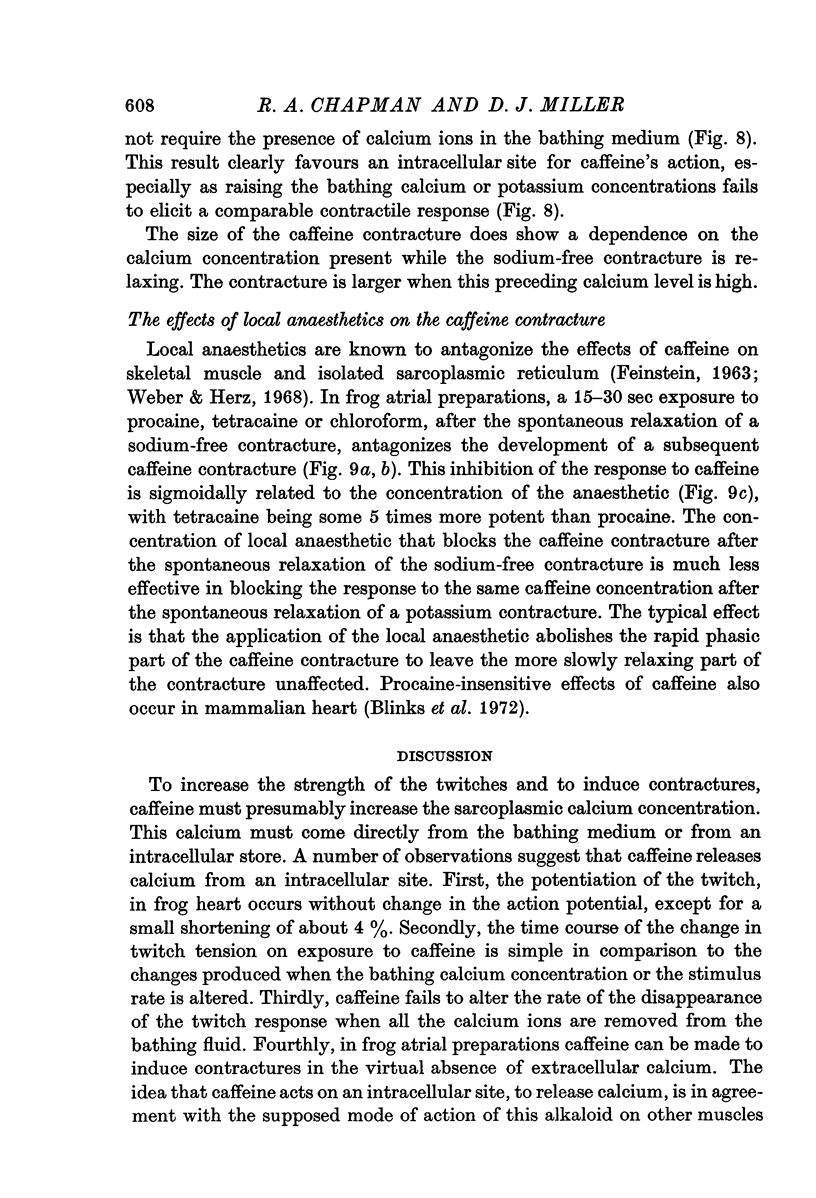
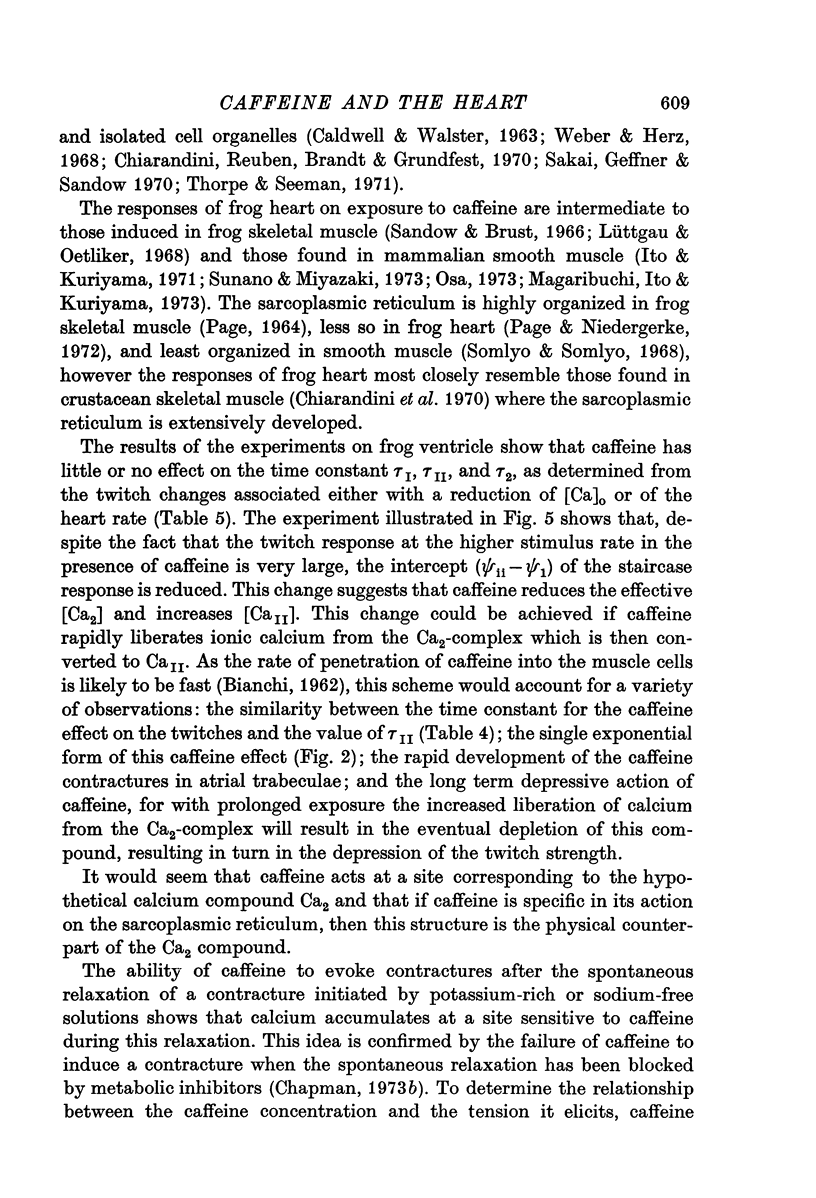
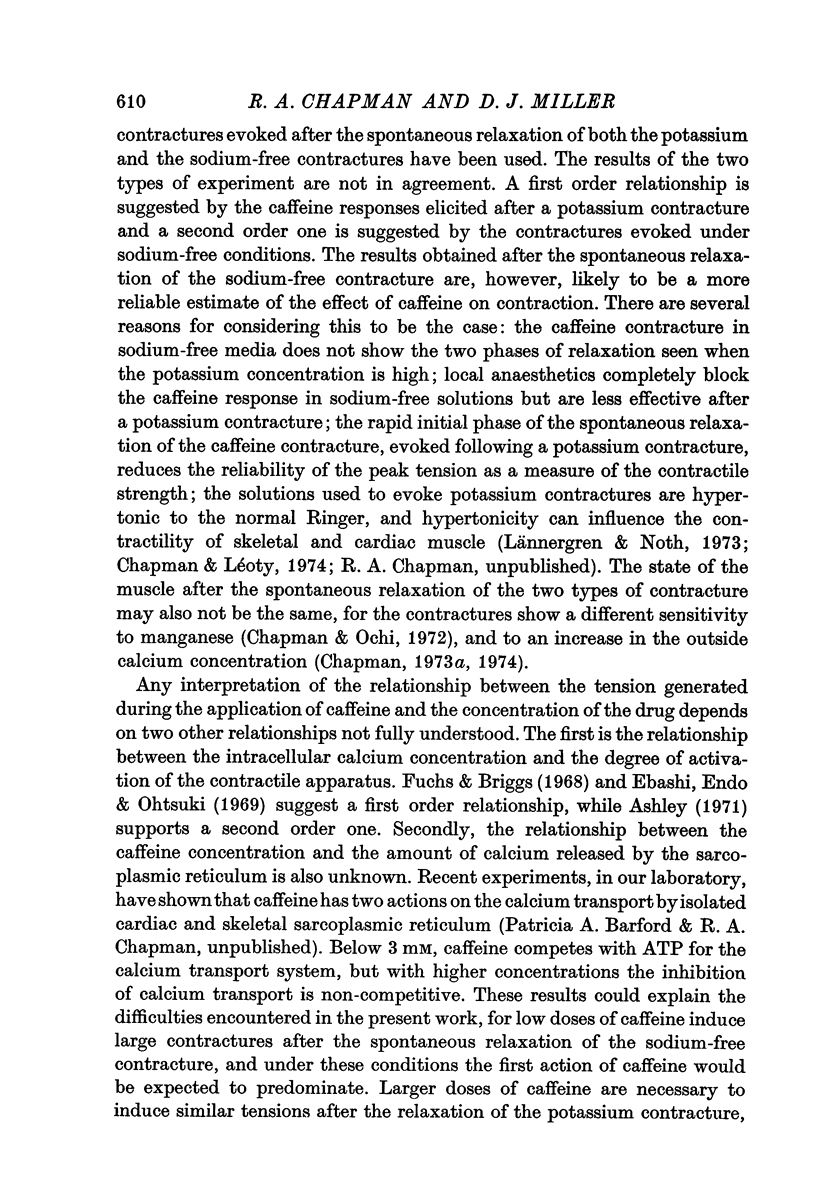
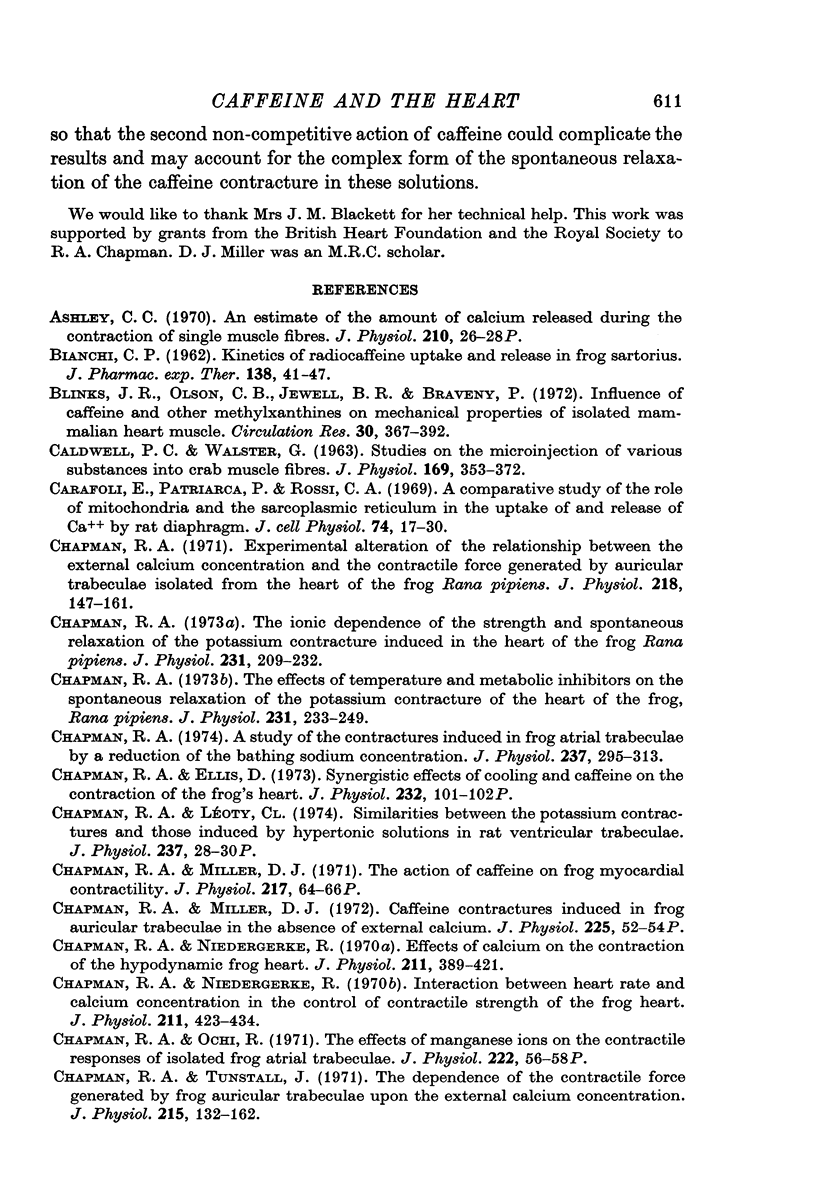
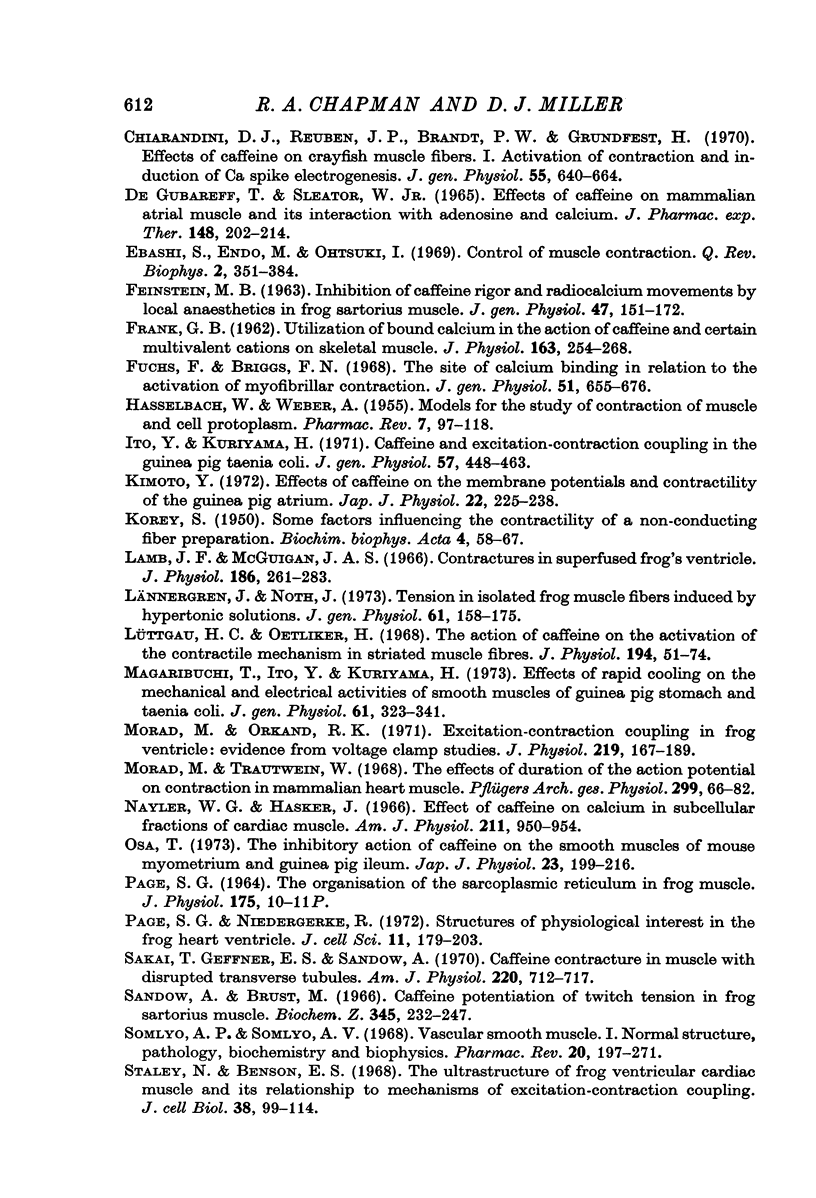
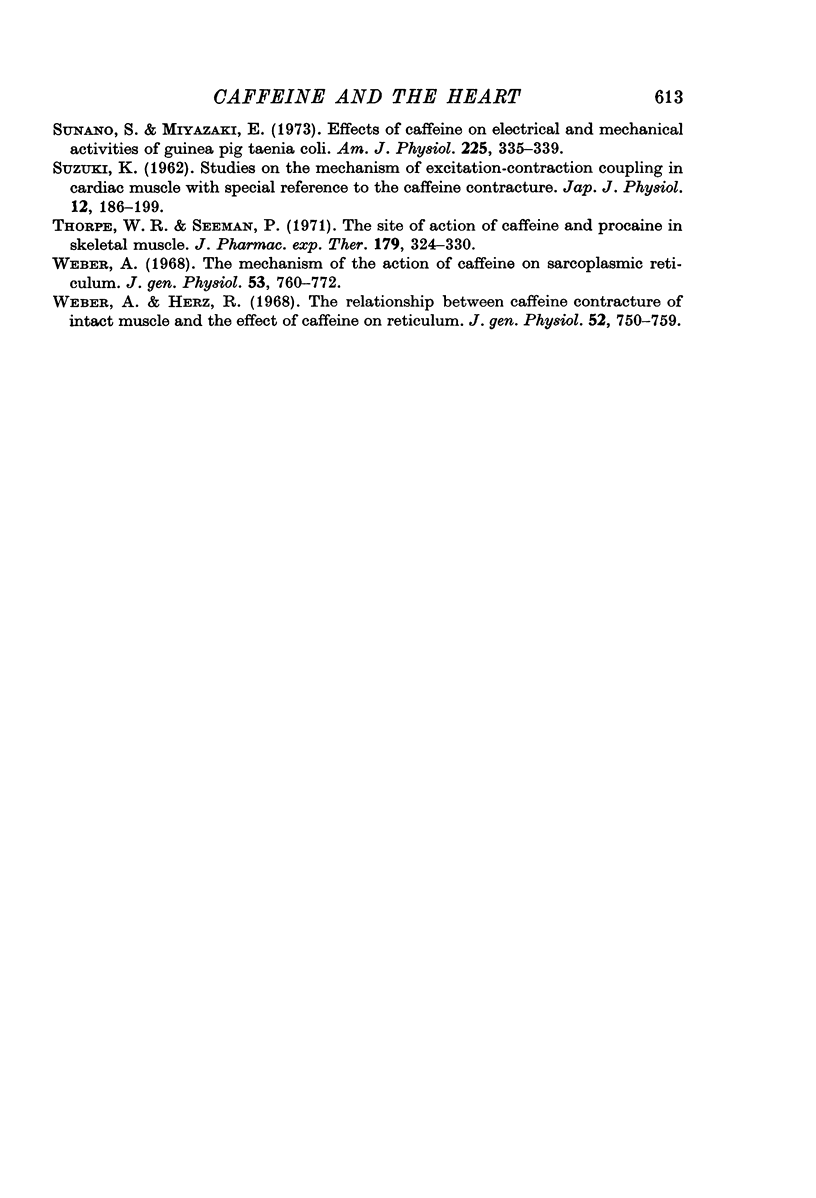
Selected References
These references are in PubMed. This may not be the complete list of references from this article.
- BIANCHI C. P. Kinetics of radiocaffeine uptake and release in frog sartorius. J Pharmacol Exp Ther. 1962 Oct;138:41–47. [PubMed] [Google Scholar]
- Blinks J. R., Olson C. B., Jewell B. R., Bravený P. Influence of caffeine and other methylxanthines on mechanical properties of isolated mammalian heart muscle. Evidence for a dual mechanism of action. Circ Res. 1972 Apr;30(4):367–392. doi: 10.1161/01.res.30.4.367. [DOI] [PubMed] [Google Scholar]
- CALDWELL P. C., WALSTER G. STUDIES ON THE MICRO-INJECTION OF VARIOUS SUBSTANCES INTO CRAB MUSCLE FIBRES. J Physiol. 1963 Nov;169:353–372. doi: 10.1113/jphysiol.1963.sp007261. [DOI] [PMC free article] [PubMed] [Google Scholar]
- Carafoli E., Patriarca P., Rossi C. S. A comparative study of the role of mitochondria and the sarcoplasmic reticulum in the uptake and release of Ca++ by the rat diaphragm. J Cell Physiol. 1969 Aug;74(1):17–30. doi: 10.1002/jcp.1040740104. [DOI] [PubMed] [Google Scholar]
- Chapman R. A. A study of the contractures induced in frog atrial trabeculae by a reduction of the bathing sodium concentration. J Physiol. 1974 Mar;237(2):295–313. doi: 10.1113/jphysiol.1974.sp010483. [DOI] [PMC free article] [PubMed] [Google Scholar]
- Chapman R. A., Ellis D. Synergistic effects of cooling and caffeine on the contraction of the frog's heart. J Physiol. 1973 Jul;232(2):101P–102P. [PubMed] [Google Scholar]
- Chapman R. A. Experimental alteration of the relationship between the external calcium concentration and the contractile force generated by auricular trabeculae isolated from the heart of the frog, Rana pipiens. J Physiol. 1971 Oct;218(1):147–161. doi: 10.1113/jphysiol.1971.sp009608. [DOI] [PMC free article] [PubMed] [Google Scholar]
- Chapman R. A., Miller D. J. Caffeine contractures induced in frog auricular trabeculae in the absence of external calcium. J Physiol. 1972 Sep;225(2):52P–54P. [PubMed] [Google Scholar]
- Chapman R. A., Miller D. J. The action of caffeine on frog myocardial contractility. J Physiol. 1971;217 (Suppl):64P–66P. [PubMed] [Google Scholar]
- Chapman R. A., Niedergerke R. Effects of calcium on the contraction of the hypodynamic frog heart. J Physiol. 1970 Dec;211(2):389–421. doi: 10.1113/jphysiol.1970.sp009284. [DOI] [PMC free article] [PubMed] [Google Scholar]
- Chapman R. A., Niedergerke R. Interaction between heart rate and calcium concentration in the control of contractile strength of the frog heart. J Physiol. 1970 Dec;211(2):423–443. doi: 10.1113/jphysiol.1970.sp009285. [DOI] [PMC free article] [PubMed] [Google Scholar]
- Chapman R. A., Ochi R. The effects of manganese ions on the contractile responses of isolated frog atrial trabeculae. J Physiol. 1972 Apr;222(1):56P–58P. [PubMed] [Google Scholar]
- Chapman R. A. The effects of temperature and metabolic inhibitors on the spontaneous relaxation of the potassium contracture of the heart of the frog Rana pipiens. J Physiol. 1973 Jun;231(2):233–249. doi: 10.1113/jphysiol.1973.sp010230. [DOI] [PMC free article] [PubMed] [Google Scholar]
- Chapman R. A. The onic dependence of the strength and spontaneous relations of the potassium contracture induced in the heart of the frog Rana pipiens. J Physiol. 1973 Jun;231(2):209–232. doi: 10.1113/jphysiol.1973.sp010229. [DOI] [PMC free article] [PubMed] [Google Scholar]
- Chapman R. A., Tunstall J. The dependence of the contractile force generated by frog auricular trabeculae upon the external calcium concentration. J Physiol. 1971 May;215(1):139–162. doi: 10.1113/jphysiol.1971.sp009462. [DOI] [PMC free article] [PubMed] [Google Scholar]
- Chiarandini D. J., Reuben J. P., Brandt P. W., Grundfest H. Effects of caffeine on crayfish muscle fibers. I. Activation of contraction and induction of Ca spike electrogenesis. J Gen Physiol. 1970 May;55(5):640–664. doi: 10.1085/jgp.55.5.640. [DOI] [PMC free article] [PubMed] [Google Scholar]
- DEGUBAREFF T., SLEATOR W., Jr EFFECTS OF CAFFEINE ON MAMMALIAN ATRIAL MUSCLE, AND ITS INTERACTION WITH ADENOSINE AND CALCIUM. J Pharmacol Exp Ther. 1965 May;148:202–214. [PubMed] [Google Scholar]
- Ebashi S., Endo M., Otsuki I. Control of muscle contraction. Q Rev Biophys. 1969 Nov;2(4):351–384. doi: 10.1017/s0033583500001190. [DOI] [PubMed] [Google Scholar]
- FEINSTEIN M. B. INHIBITION OF CAFFEINE RIGOR AND RADIOCALCIUM MOVEMENTS BY LOCAL ANESTHETICS IN FROG SARTORIUS MUSCLE. J Gen Physiol. 1963 Sep;47:151–172. doi: 10.1085/jgp.47.1.151. [DOI] [PMC free article] [PubMed] [Google Scholar]
- FRANK G. B. Utilization of bound calcium in the action of caffeine and certain multivalent cations on skeletal muscle. J Physiol. 1962 Sep;163:254–268. doi: 10.1113/jphysiol.1962.sp006972. [DOI] [PMC free article] [PubMed] [Google Scholar]
- Fuchs F., Briggs F. N. The site of calcium binding in relation to the activation of myofibrillar contraction. J Gen Physiol. 1968 May;51(5):655–676. doi: 10.1085/jgp.51.5.655. [DOI] [PMC free article] [PubMed] [Google Scholar]
- HASSELBACH W., WEBER A. Models for the study of the contraction of muscle and of cell protoplasm. Pharmacol Rev. 1955 Mar;7(1):97–117. [PubMed] [Google Scholar]
- Ito Y., Kuriyama H. Caffeine and excitation-contraction coupling in the guinea pig taenia coli. J Gen Physiol. 1971 Apr;57(4):448–463. doi: 10.1085/jgp.57.4.448. [DOI] [PMC free article] [PubMed] [Google Scholar]
- KOREY S. Some factors influencing the contractility of a non-conducting fiber preparation. Biochim Biophys Acta. 1950 Jan;4(1-3):58–67. doi: 10.1016/0006-3002(50)90009-6. [DOI] [PubMed] [Google Scholar]
- Kimoto Y. Effects of caffeine on the membrane potentials and contractility of the guinea pig atrium. Jpn J Physiol. 1972 Apr;22(2):225–238. doi: 10.2170/jjphysiol.22.225. [DOI] [PubMed] [Google Scholar]
- Lamb J. F., McGuigan J. A. Contractures in a superfused frog's ventricle. J Physiol. 1966 Oct;186(2):261–283. doi: 10.1113/jphysiol.1966.sp008033. [DOI] [PMC free article] [PubMed] [Google Scholar]
- Lännergren J., Noth J. Tension in isolated frog muscle fibers induced by hypertonic solutions. J Gen Physiol. 1973 Feb;61(2):158–175. doi: 10.1085/jgp.61.2.158. [DOI] [PMC free article] [PubMed] [Google Scholar]
- Lüttgau H. C., Oetliker H. The action of caffeine on the activation of the contractile mechanism in straited muscle fibres. J Physiol. 1968 Jan;194(1):51–74. doi: 10.1113/jphysiol.1968.sp008394. [DOI] [PMC free article] [PubMed] [Google Scholar]
- Magaribuchi T., Ito Y., Kuriyama H. Effects of rapid cooling on the mechanical and electrical activities of smooth muscles of guinea pig stomach and taenia coli. J Gen Physiol. 1973 Mar;61(3):323–341. doi: 10.1085/jgp.61.3.323. [DOI] [PMC free article] [PubMed] [Google Scholar]
- Morad M., Orkand R. K. Excitation-concentration coupling in frog ventricle: evidence from voltage clamp studies. J Physiol. 1971 Dec;219(1):167–189. doi: 10.1113/jphysiol.1971.sp009656. [DOI] [PMC free article] [PubMed] [Google Scholar]
- Morad M., Trautwein W. The effect of the duration of the action potential on contraction in the mammalian heart muscle. Pflugers Arch Gesamte Physiol Menschen Tiere. 1968;299(1):66–82. doi: 10.1007/BF00362542. [DOI] [PubMed] [Google Scholar]
- Nayler W. G., Hasker J. R. Effect of caffeine on calcium in subcellular fractions of cardiac muscle. Am J Physiol. 1966 Oct;211(4):950–954. doi: 10.1152/ajplegacy.1966.211.4.950. [DOI] [PubMed] [Google Scholar]
- Osa T. The inhibitory action of caffeine on the smooth muscles of mouse myometrium and guinea pig ileum. Jpn J Physiol. 1973 Apr;23(2):199–216. doi: 10.2170/jjphysiol.23.199. [DOI] [PubMed] [Google Scholar]
- Page S. G., Niedergerke R. Structures of physiological interest in the frog heart ventricle. J Cell Sci. 1972 Jul;11(1):179–203. doi: 10.1242/jcs.11.1.179. [DOI] [PubMed] [Google Scholar]
- SUZUKI K. Studies on the mechanism of the excitation-contraction coupling in cardiac muscle, with special reference to the caffeine-contracture. Jpn J Physiol. 1962 Apr 15;12:186–199. doi: 10.2170/jjphysiol.12.186. [DOI] [PubMed] [Google Scholar]
- Sakai T., Geffner E. S., Sandow A. Caffeine contracture in muscle with disrupted transverse tubules. Am J Physiol. 1971 Mar;220(3):712–717. doi: 10.1152/ajplegacy.1971.220.3.712. [DOI] [PubMed] [Google Scholar]
- Somlyo A. P., Somlyo A. V. Vascular smooth muscle. I. Normal structure, pathology, biochemistry, and biophysics. Pharmacol Rev. 1968 Dec;20(4):197–272. [PubMed] [Google Scholar]
- Staley N. A., Benson E. S. The ultrastructure of frog ventricular cardiac muscle and its relationship to mechanism of excitation-contraction coupling. J Cell Biol. 1968 Jul;38(1):99–114. doi: 10.1083/jcb.38.1.99. [DOI] [PMC free article] [PubMed] [Google Scholar]
- Sunano S., Miyazaki E. Effects of caffeine on electrical and mechanical activities of guinea pig taenia coli. Am J Physiol. 1973 Aug;225(2):335–339. doi: 10.1152/ajplegacy.1973.225.2.335. [DOI] [PubMed] [Google Scholar]
- Thorpe W. R., Seeman P. The site of action of caffeine and procaine in skeletal muscle. J Pharmacol Exp Ther. 1971 Nov;179(2):324–330. [PubMed] [Google Scholar]
- Weber A., Herz R. The relationship between caffeine contracture of intact muscle and the effect of caffeine on reticulum. J Gen Physiol. 1968 Nov;52(5):750–759. doi: 10.1085/jgp.52.5.750. [DOI] [PMC free article] [PubMed] [Google Scholar]
- Weber A. The mechanism of the action of caffeine on sarcoplasmic reticulum. J Gen Physiol. 1968 Nov;52(5):760–772. doi: 10.1085/jgp.52.5.760. [DOI] [PMC free article] [PubMed] [Google Scholar]


